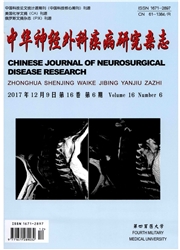

 中文摘要:
中文摘要:
目的从不同病理级别胶质瘤组织标本中分离、培养并鉴定胶质瘤干细胞。方法取25例(23例原发胶质瘤,2例复发胶质瘤)新鲜人脑胶质细胞瘤标本,分离脑肿瘤细胞,接种于含生长因子的无血清达尔伯克(氏)必需基本培养基/F-12(DMEM/F-12)培养基中培养至细胞形成干细胞球,免疫荧光法检测脑肿瘤干细胞CD133、Nestin的表达情况,干细胞球诱导分化后检测细胞表面分化标记物B微管蛋白Ⅲ(13-TubulinIII)、神经胶质酸性蛋白(GFAP)表达情况。结果被检测的23例原发胶质瘤标本中,随着胶质瘤级别的增高,形成神经球的时间缩短,数量增多。2例复发胶质瘤组织分离得到的细胞形成的神经球较原发胶质瘤快而多。免疫荧光方法检测神经球CD133、巢蛋白(Nestin)表达阳性。神经球细胞经诱导分化后13-TubulinIII、GFAP表达阳性。结论胶质瘤组织中存在肿瘤干细胞,不同级别胶质瘤中BTSC数量及增殖能力不同。
 英文摘要:
英文摘要:
Objective To isolate, culture and identify the brain tumor stem cells from glioma specimens of different pathological grades. Methods A total of 25 cases of fresh glioblastoma specimens were picked out and dissociated, and the cells were planted in serum-free medium with growth factor. CD133, Nestin, and multipotentiality nmrkers β-Tubulin III and glial fibrillary acidic protein (GFAP) were detected using immunofluorescence analysis. Results The number of neurospheres was increased significantly with the increase of glioma malignancy. These neurospheres were CD133 and Nestin positive staining. After differentiation, β-Tubulin III and GFAP were expressed. Conclusion The brain glioma stem cells do exist in glioblastoma, but the number and reproductive ability vary in gliomas of different pathological grades.
 同期刊论文项目
同期刊论文项目
 同项目期刊论文
同项目期刊论文
 期刊信息
期刊信息
